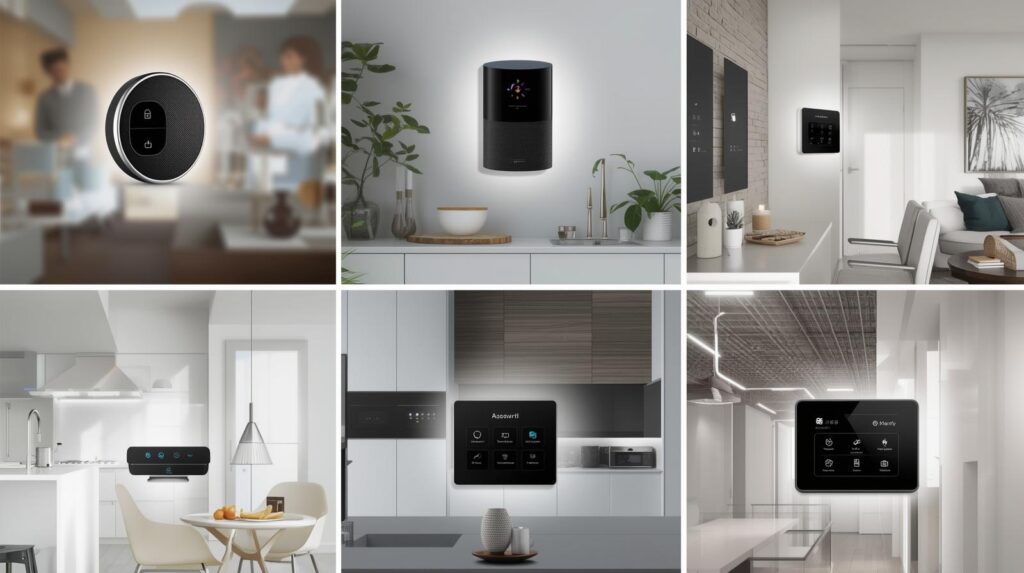As the smart home industry evolves, certain companies are consistently emerging ahead of the curve — thanks to strong product portfolios, innovation, global reach, and investment in AI/IoT. According to a recent MarketsandMarkets report, Smart Home Industry worth $116.4 billion by 2029.
Here are the leaders and what sets them apart.
Key Market Leaders
The report names the following as the major players in the smart home industry:
- Johnson Controls Inc. (Ireland)
- Honeywell International Inc. (USA)
- Schneider Electric (France)
- Siemens (Germany)
- ASSA ABLOY (Sweden)
- Amazon.com, Inc. (USA)
- Apple Inc. (USA)
- ADT (USA)
- Robert Bosch (Germany)
- ABB (Switzerland)
Also recognized among other significant players are:
Samsung Electronics, Sony, Ecobee, LG, Legrand, Control4, Axis Communications, Crestron, SimpliSafe, Canary, etc.
What Makes These Leaders Strong
Based on the report, here are the key strengths and strategies that distinguish these companies:
Factor How the Leaders Leverage It
Diversified Product Portfolios : Leaders like Johnson Controls, Honeywell, Schneider Electric offer broad smart home systems covering security, HVAC, lighting, controls, etc.
Global Presence & Distribution Networks : They have established channels in multiple regions, which helps in capturing both developed and emerging markets.
Investment in AI, IoT, Connectivity : Using technologies to enable more predictive and behavior-based offerings; this improves user convenience and personalization.
Strong R&D and Innovation : Product launches, acquisitions, partnerships are used to stay ahead. For example, smart kitchen segments, lighting control innovations are growing fast.
Focus on Energy Efficiency, Security & Sustainability: These are major drivers — regulatory push in green building, consumer demand for lower energy bills & safer homes. Leaders are aligning with these.
Download PDF Brochure @ https://www.marketsandmarkets.com/pdfdownloadNew.asp?id=121

Regions Where Leaders Are Gaining Ground
- Asia‑Pacific is expected to grow fastest (~8.4 % CAGR) due to rising urbanization, disposable income, and shifting lifestyle in countries like China, South Korea, Japan, etc.
- North America & Europe remain strong in terms of mature infrastructure, higher adoption rates, and more demand for premium / integrated smart home systems.
- Challenges & Barriers, Even for Leaders
Even the top companies face nontrivial challenges:
Interoperability and fragmented standards — devices from different vendors often struggle to work seamlessly together.
High switching costs / upfront costs — consumers may be reluctant to invest heavily unless ROI (energy savings, convenience) is clear.
Privacy & security concerns — With more connected devices, data breach risk, misuse, etc., can dampen consumer trust.
Why These Players Are Likely to Maintain / Extend Their Lead
Leaders are not only responding to current trends but are investing for future ones (AI, Gen‑AI, connected appliances, sustainable home tech).
Mergers, acquisitions, and partnerships are common to broaden capabilities and fill gaps (e.g. security, connectivity, voice control etc.).
Companies with strong ecosystems (e.g. Amazon with Alexa, Apple with HomeKit) have an edge because consumers prefer platforms where many things “just work” together.
To sum up, the smart home market is being led largely by established players with global scale, wide product breadth, and strong R&D + go-to‑market strategies. Johnson Controls, Honeywell, Schneider Electric, Siemens, ASSA ABLOY, Amazon, Apple, Bosch, ABB, and ADT are repeatedly identified as front‑runners. However, the market is dynamic: smaller, more agile companies and startups that deliver seamless integration, AI‑led personalization, or cost‑efficient solutions also have opportunities to disrupt.
Smart Home Industry 2025 – FAQ for Investors
1. Why should investors pay attention to the smart home industry in 2025?
The smart home sector is transitioning from novelty to necessity. As AI, IoT, and energy tech mature, smart homes are becoming central to residential living — offering investors strong exposure to hardware, software, data analytics, energy management, and consumer tech. With rising global demand, the sector presents a diversified, scalable, and future-proof investment opportunity.
2. What’s the market size and expected growth?
- Market Value (2024): USD 84.5 billion
- Projected Value (2029): $116.4 billion
- CAGR (2024–2029): 6.6%
3. What are the top investment opportunities in the smart home ecosystem?
- AI & Predictive Automation: Software platforms that personalize user experiences.
- Smart Security & Surveillance: Cameras, sensors, and monitoring services.
- Energy Management: Thermostats, solar integration, home batteries, grid optimization.
- Voice & Gesture Interfaces: Natural user interfaces that drive adoption.
- Health & Wellness Tech: Air quality sensors, sleep monitors, aging-in-place solutions.
- Subscription Services: Bundled solutions offering recurring revenue streams.
- Interoperability Platforms: Matter-compliant hubs & ecosystems.
4. Who are the market leaders and why?
Top players include Amazon, Apple, Google, Schneider Electric, Johnson Controls, Honeywell, ABB, Bosch, and ADT.
They dominate due to:
- Global brand equity
- Vertical integration (hardware + software)
- Strong AI/IoT R&D pipelines
- Robust supply and distribution networks
- Platform-based ecosystems (e.g., Alexa, HomeKit, Nest)